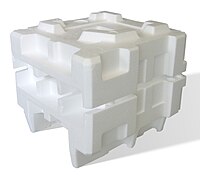
Photo from wikipedia
In this article, expanded vermiculite (EV)-enhanced polyurethane foam bionic composites inspired by pomelo peel is proposed. The columnar lattice structure mold is employed to constitute the periodic interface structure and… Click to show full abstract
In this article, expanded vermiculite (EV)-enhanced polyurethane foam bionic composites inspired by pomelo peel is proposed. The columnar lattice structure mold is employed to constitute the periodic interface structure and gradient foam structure, and the nylon nonwoven fabric is combined as the surface layer. The effects of EV content on the thermal, compression, and dynamic cushion properties of bionic composites are investigated. Results show that residual char increases with EV content, which conduces to decrease the release of heat flow. The proposed bionic composite with columnar lattice structure has optimal compressive modulus, energy absorption and dynamic cushion efficacy when 1 wt% EV is added. However, its performance decreases slowly when EV fillers are continuously added because the cell morphology is changed from round to irregular shape and the interfacial adhesion of filler–matrix is weakened. Owing to their unique bionic structure, composites can absorb 99% of the energy impacted by flat impactor within a smaller deformation and achieve 97% absorption efficiency for a hemispheric impactor in cushion test.
Journal Title: Polymers
Year Published: 2019
Link to full text (if available)
Share on Social Media: Sign Up to like & get
recommendations!